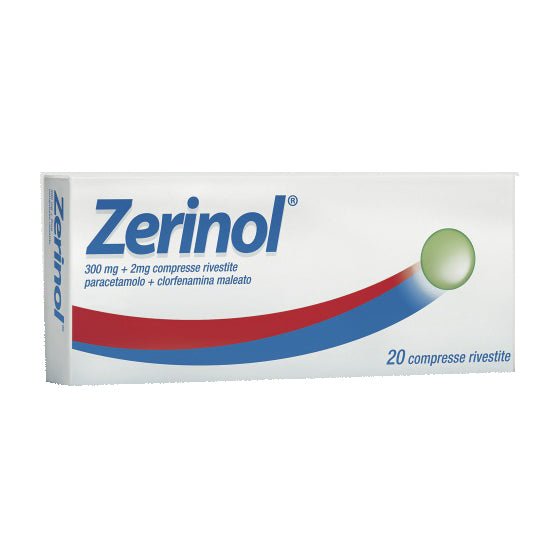ZENTIVA ITALIA Srl
Zerinol 300mg + 2mg 20 coated tablets
Zerinol 300mg + 2mg 20 coated tablets
Regular price
€12,80
Regular price
€12,80
Sale price
€12,80
Unit price
per
Taxes included.
Shipping calculated at checkout.

Pickup available at Farmacia Tili
Usually ready in 24 hours
PRODUCT NET WEIGHT
PRODUCT NET WEIGHT
EAN
EAN
035304043
MINSAN
MINSAN
035304043
Zerinol 300mg + 2mg 20 coated tablets is a medicine formulated for the treatment of flu and cold symptoms in adults. Each tablet contains paracetamol 300 mg and chlorphenamine maleate 2 mg , two active ingredients known for their analgesic and antihistamine properties. Paracetamol is widely used to relieve pain and reduce fever, while chlorphenamine maleate helps reduce allergy symptoms such as runny nose and sneezing. This product is available in a pack of 20 coated tablets , designed for convenient and effective oral intake. The formulation also includes excipients such as sucrose , which is an excipient with known effects. Zerinol is indicated for those seeking rapid and targeted relief from flu and cold symptoms, thanks to the synergistic combination of its active components.
ACTIVE INGREDIENTS
Active ingredients contained in Zerinol 300mg + 2mg 20 coated tablets - What is the active ingredient of Zerinol 300mg + 2mg 20 coated tablets?
One coated tablet contains: paracetamol 300 mg, chlorphenamine maleate 2 mg. Excipient with known effect: sucrose. For the full list of excipients, see section 6.1.EXCIPIENTS
Composition of Zerinol 300mg + 2mg 20 coated tablets - What does Zerinol 300mg + 2mg 20 coated tablets contain?
Corn starch; microcrystalline cellulose; povidone; magnesium stearate; carmellose sodium; talc; sucrose; gelatin; macrogol 6000; calcium carbonate; water-soluble chlorophyll; gum arabic; carnauba wax.DIRECTIONS
Therapeutic indications Zerinol 300mg + 2mg 20 coated tablets - Why is Zerinol 300mg + 2mg 20 coated tablets used? What is it used for?
Treatment of cold and flu symptoms in adults.CONTRAINDICATIONS SIDE EFFECTS
Contraindications Zerinol 300mg + 2mg 20 coated tablets - When should Zerinol 300mg + 2mg 20 coated tablets not be used?
Zerinol is contraindicated in the following cases: - hypersensitivity to paracetamol or chlorphenamine, to other antihistamines of similar chemical structure or to any of the excipients listed in paragraph 6.1; - pregnancy and breastfeeding; - patients with manifest glucose-6-phosphate dehydrogenase insufficiency and patients with severe haemolytic anaemia; - severe hepatocellular insufficiency (Child-Pugh C); - glaucoma, prostatic hypertrophy, obstruction of the bladder neck, pyloric and duodenal stenosis or of other tracts of the gastrointestinal and urogenital system, due to the anticholinergic effects; - patients being treated with monoamine oxidase inhibitors (MAOIs) or in the two weeks following such treatment (see paragraph 4.5).DOSAGE
Quantity and method of taking Zerinol 300mg + 2mg 20 coated tablets - How to take Zerinol 300mg + 2mg 20 coated tablets?
Dosage Adults: 1 coated tablet, twice daily. Paediatric population: the safety and efficacy of Zerinol in patients under 18 years of age have not been established. Method of administration Oral use. The tablet should be taken with water after meals. Duration of treatment Patients should be advised to contact their doctor if fever persists or symptoms do not improve after 3 days of treatment (see section 4.4).CONSERVATION
Storage Zerinol 300mg + 2mg 20 coated tablets - How to store Zerinol 300mg + 2mg 20 coated tablets?
This medicinal product does not require any special storage conditions.WARNINGS
Warnings Zerinol 300mg + 2mg 20 coated tablets - About Zerinol 300mg + 2mg 20 coated tablets it is important to know that:
Do not administer for more than 3 consecutive days without consulting your doctor. If the fever persists for more than three days or if the symptoms do not improve and new symptoms appear within three days or are accompanied by high fever, rash, excessive mucus and persistent cough, consult your doctor before continuing administration. Paracetamol During treatment with Zerinol, check that no other medicine containing paracetamol is taken at the same time, since if paracetamol is taken in high doses, serious adverse reactions may occur. Instruct the patient to contact their doctor before combining any other medicine. See also section 4.5. High or prolonged doses of the product can cause high-risk liver disease (see also section 4.9) and alterations to the kidney and blood, which may be serious. In case of acute hypersensitivity reactions to paracetamol (e.g. anaphylactic shock), treatment with Zerinol must be stopped and the necessary medical measures must be implemented based on the signs and symptoms. Chlorphenamine maleate At common therapeutic doses, antihistamines present side effects that vary greatly from subject to subject and from compound to compound. The most frequent side effect is sedation that may manifest itself with drowsiness; those who may drive vehicles or perform operations that require full alertness must be warned of this (see paragraph 4.7). Patients with renal or hepatic insufficiency Administer with caution in subjects with renal or hepatic insufficiency. Elderly Particular attention should be paid when determining the dose in the elderly due to their greater sensitivity to the drug. In elderly patients treated with antihistamines, effects such as dizziness, sedation, confusion and hypotension are more likely to occur. Elderly patients are particularly sensitive to the anticholinergic side effects of antihistamines such as dry mouth and urinary retention (especially in men). Sucrose Patients with rare hereditary problems of fructose intolerance, glucose-galactose malabsorption or sucrose-isomaltase insufficiency should not take this medicine.INTERACTIONS
Interactions Zerinol 300mg + 2mg 20 coated tablets - Which medicines or foods can modify the effect of Zerinol 300mg + 2mg 20 coated tablets?
Paracetamol Use with extreme caution and under close supervision during chronic treatment with drugs that can determine the induction of hepatic monooxygenases or in case of exposure to substances that can have this effect (for example rifampicin, cimetidine, antiepileptics such as glutethimide, phenobarbital, carbamazepine). Normally harmless doses of paracetamol can cause liver damage if taken together with these drugs. The same applies to potentially hepatotoxic substances and in case of alcohol abuse. The habitual ingestion of anticonvulsant drugs or oral contraceptives can, with an enzymatic induction mechanism, accelerate the metabolism of paracetamol. It is not advisable to use the product if the patient is being treated with anti-inflammatory drugs. Probenecid inhibits the binding of paracetamol to glucuronic acid, thereby reducing the clearance of paracetamol by a factor of approximately 2. Therefore, the dose of paracetamol should be reduced if administered in combination with probenecid. Cholestyramine reduces the absorption of paracetamol if administered within 1 h of paracetamol administration. The clinical relevance of interactions between paracetamol and oral anticoagulants has not yet been established. Therefore, prolonged use of paracetamol in patients receiving oral anticoagulants is only advisable under medical supervision. The combination of paracetamol with chloramphenicol may prolong the half-life of chloramphenicol, increasing the risk of toxicity. Concomitant use of paracetamol and zidovudine increases the tendency of the latter to reduce the number of leukocytes (neutropenia). Therefore, Zerinol should be taken with zidovudine only under medical supervision. Medicines that slow gastric emptying, such as propantheline, reduce the rate of absorption of paracetamol and delay the onset of its effect. Medicines that accelerate gastric emptying, such as metoclopramide, lead to an increase in the rate of absorption. Interference with laboratory tests The administration of paracetamol may interfere with the determination of uric acid (using the phosphotungstic acid method) and blood glucose (using the glucose-oxidase-peroxidase method). Chlorphenamine maleate Other substances with anticholinergic action should not be taken at the same time as Zerinol, as these may cause significant interactions. The product is contraindicated in patients undergoing treatment with monoamine oxidase inhibitors (MAOIs) or in the two weeks following such treatment (see section 4.3) as these may prolong and intensify the anticholinergic and central nervous system (CNS) depressant effects of chlorphenamine maleate. The product may interact with alcohol, tricyclic antidepressants, neuroleptics or other drugs that depress the central nervous system such as barbiturates, sedatives, tranquilizers, hypnotics. These products should not be taken during therapy with Zerinol because they can cause an increase in the sedative effect. The use of antihistamines can mask the first signs of ototoxicity of certain antibiotics. Chlorphenamine inhibits the metabolism of phenytoin and can cause phenytoin toxicity.SIDE EFFECTS
Like all medicines, Zerinol 300mg + 2mg 20 coated tablets can cause side effects - What are the side effects of Zerinol 300mg + 2mg 20 coated tablets?
Following the use of Zerinol, the following undesirable effects may occur. The frequency of these undesirable effects cannot be estimated from the available data. Blood and lymphatic system disorders : - thrombocytopenia, leukopenia, anaemia, agranulocytosis, pancytopenia. Immune system disorders : - hypersensitivity reactions such as angioedema, laryngeal edema, anaphylactic shock. Nervous system disorders : - drowsiness, asthenia, dizziness, headache, inability to concentrate. Eye disorders : - blurred vision. Respiratory, thoracic and mediastinal disorders : - thickening of bronchial secretions. Gastrointestinal disorders : - dry mouth, nausea. Hepatobiliary disorders: - alterations in liver function and hepatitis. Skin and subcutaneous tissue disorders : - skin reactions of various types and severity have been reported with the use of paracetamol, including cases of urticaria, erythema multiforme, very rare cases of severe skin reactions such as Stevens-Johnson syndrome (SJS), toxic epidermal necrolysis (TEN) and acute generalized exanthematous pustulosis (AGEP). Photosensitization. Renal and urinary disorders : - renal disorders (acute renal failure, interstitial nephritis, haematuria, anuria), urinary retention. Reporting of suspected adverse reactions Reporting suspected adverse reactions that occur after authorisation of the medicinal product is important. It allows continued monitoring of the benefit/risk balance of the medicinal product. Healthcare professionals are asked to report any suspected adverse reactions via the national reporting system at: www.agenziafarmaco.gov.it/it/responsabili.OVERDOSE
Overdose Zerinol 300mg + 2mg 20 coated tablets - What are the risks of Zerinol 300mg + 2mg 20 coated tablets in case of overdose?
Symptoms In case of overdose, marked depressive or stimulating effects on the central nervous system, drowsiness, lethargy, respiratory depression are generally observed. In case of overdose, paracetamol, contained in Zerinol, can cause hepatic cytolysis that could evolve into massive necrosis. Therapy N-acetylcysteine, administered in the hours immediately following the ingestion of paracetamol, is effective in limiting liver damage. It is recommended to use the usual measures to remove unabsorbed material from the gastrointestinal tract; keep the patient under observation by practicing supportive therapy. Further measures will depend on the severity, nature and course of clinical symptoms and must follow standard intensive care protocols.PREGNANCY AND BREASTFEEDING
If you are pregnant or breast-feeding, think you may be pregnant or are planning to have a baby, ask your doctor for advice before taking Zerinol 300mg + 2mg 20 coated tablets.
Pregnancy and breastfeeding Zerinol is contraindicated during pregnancy and breastfeeding. Fertility No studies have been conducted with Zerinol to evaluate the effects on fertility in humans.DRIVING AND USE OF MACHINERY
Taking Zerinol 300mg + 2mg 20 coated tablets before driving or using machines - Does Zerinol 300mg + 2mg 20 coated tablets affect driving or using machines?
Patients should be advised that Zerinol may cause drowsiness. Patients who may drive or perform tasks requiring alertness should be warned of this.OUR PRODUCTS FOR THIS SEASON

























